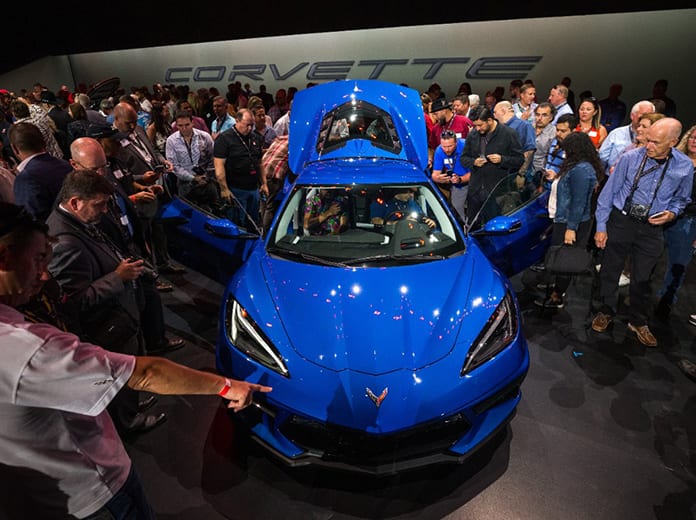
The Stingray is designed for superior ride comfort on the highway and well-balanced handling on the track.
“Thanks to sophisticated suspension geometry, tailored tire technology and exquisite attention to structural details, we have improved ride and handling,” said Juechter. “No Corvette has ever felt so comfortable, nimble and yet completely stable.”
The new Stingray features coil over dampers that create entirely new ride and handling characteristics. The mid-engine architecture allows for a short, straight and stiff steering system, coupled with an updated electronic steering system, making the driver’s chassis input instantaneous.
The new seating position places the car’s center of gravity close to the driver’s inside hip, so the car literally turns around the driver. It completely changes the perception of vehicle handling and responsiveness.
The 2020 Stingray’s heart is Chevy’s next-generation 6.2L Small Block V-8 LT2 engine, the only naturally aspirated V-8 in the segment. It will produce 495 horsepower (369 kW) and 470 lb-ft (637 Nm) of torque when equipped with performance exhaust — the most horsepower and torque for any entry Corvette.
“Though now placed behind the driver, the LT2 gives the same visceral experience we all expect from Corvette,” said Jordan Lee, GM’s global chief engineer of Small Block engines. “The LT2 has been designed to deliver excellent low-end torque and high-end power to give thrilling pedal response at any RPM.”
The powertrain’s low position enables a low center of gravity for optimal handling. Perhaps the biggest update is found in the lubrication and ventilation system. For the first time ever, the base Stingray will use an engine-mounted dry sump oil system and three scavenge pumps for improved track performance.
During serious track driving, oil volume remains high to avoid diminished performance. The new Stingray’s lateral capability is greatly improved, so the LT2’s dry sump lubrication system had to be redesigned to provide exceptional engine performance even at lateral acceleration levels exceeding 1G in all directions.
A lightweight, 3.2mm-thick glass panel on the rear hatch allows owners to show off the engine. This panel features a cantilevered trailing edge to evacuate heat from the LT2 engine compartment.
The next generation LT2 is paired with Chevrolet’s first eight speed dual-clutch transmission, which provides lightning-fast shifts and excellent power transfer. This transmission is uniquely designed with TREMEC to provide the best of both worlds: the spirited, direct connected feeling of a manual and the premium driving comfort of an automatic. The double-paddle de-clutch feature even allows the driver to disconnect the clutch by holding both paddles for more manual control.
Paddle shifters allow drivers to choose a specific gear. “The performance shift algorithms are so driver-focused, they can sense when you’re doing spirited driving — regardless of driving mode — and will hold lower gears longer for more throttle response,” said Juechter.
The new Small Block V-8 has a torque curve optimized to take advantage of the bespoke DCT’s lightning-fast shifts. Engineers set the DCT up with a very low first gear to leverage the additional traction to get the car off the line quickly, and its close-ratio gears 2 through 6 keep the engine near the power peak on track. Tall seventh and eighth gears make for easy long-distance cruising with low mechanical stress and excellent fuel economy.
The DCT is mated to a new Electronic Transmission Range Selector. With this electric shifter there’s no mechanical interface between the shift lever and the transmission. The Corvette’s electric shifter incorporates two pull toggles for Reverse and Drive and push buttons for Park, Neutral and Low/Manual. The shifter has been designed to be more attractive and compact than a standard shifter.
The entry 2020 Stingray start less than $60,000, with add-ons bringing that price up incrementally. The 2020 Chevrolet Corvette Stingray goes into production at GM’s Bowling Green Assembly in late 2019.
